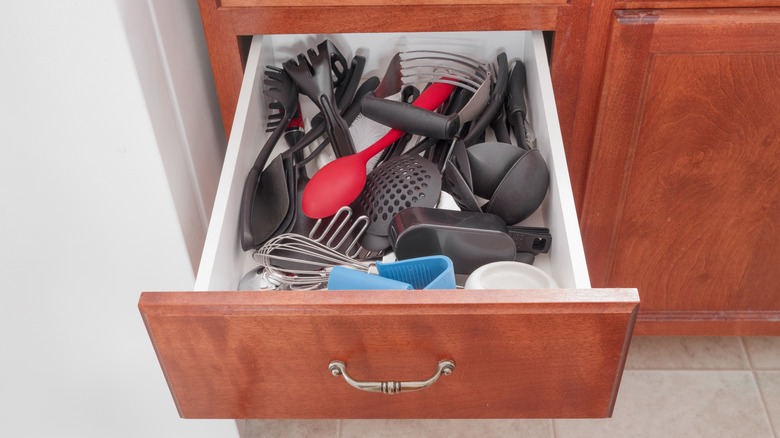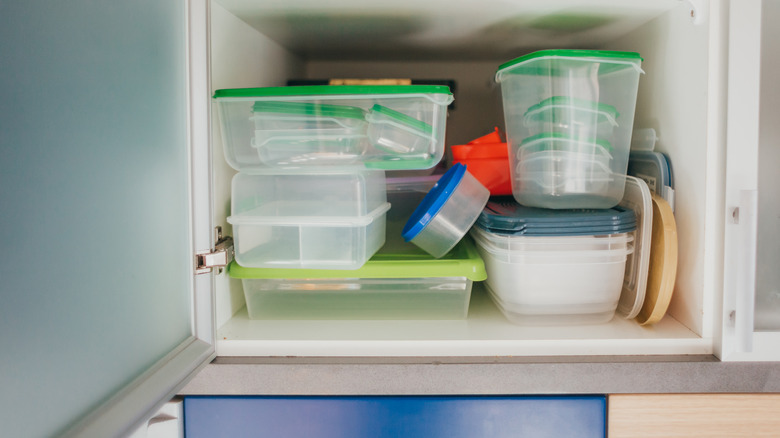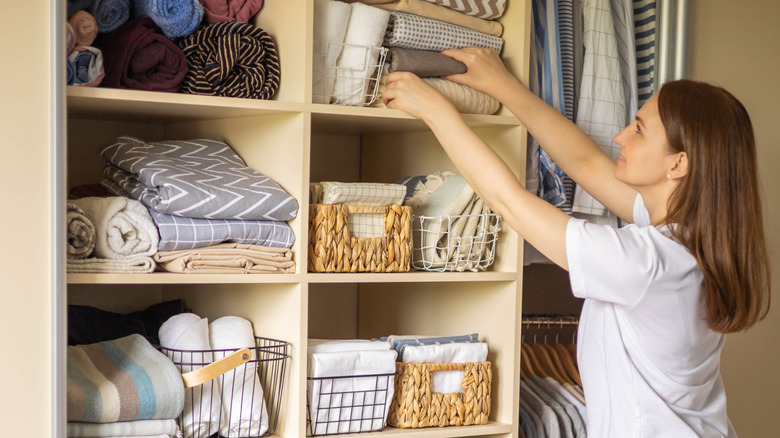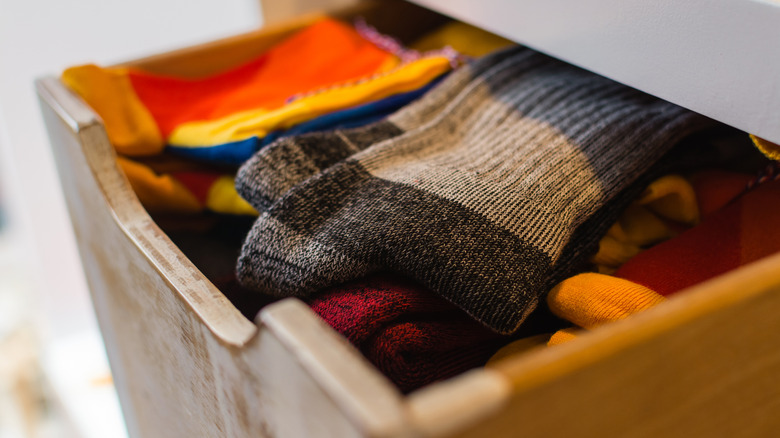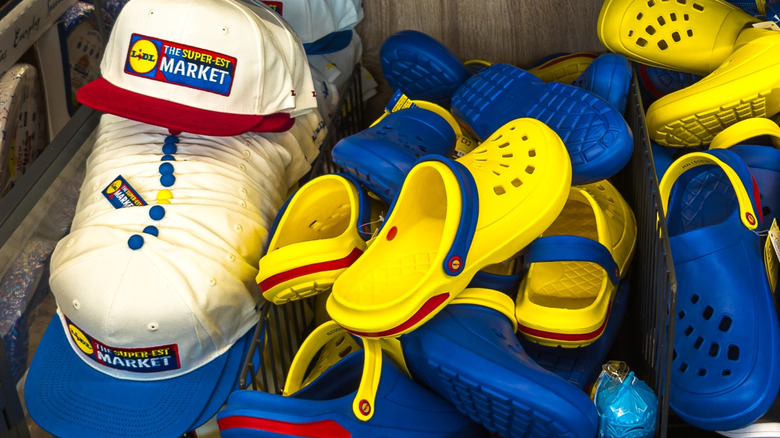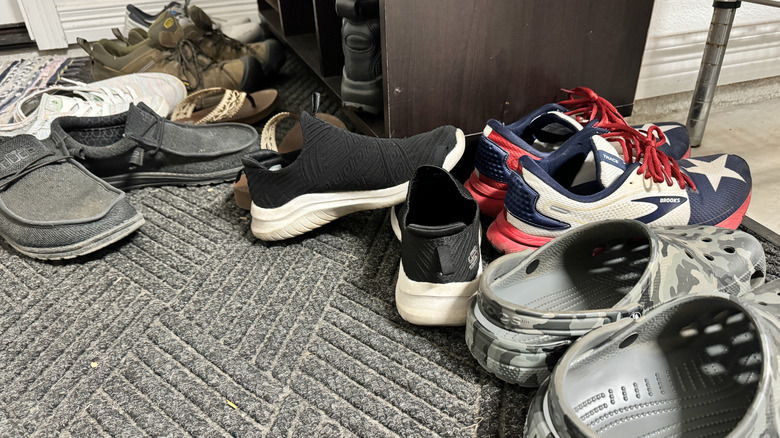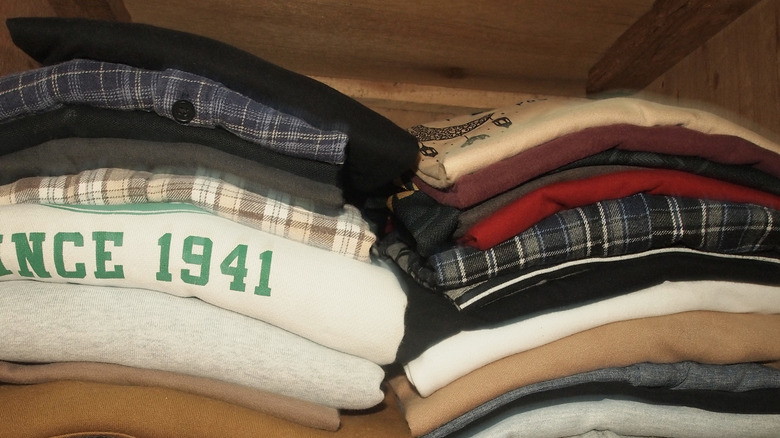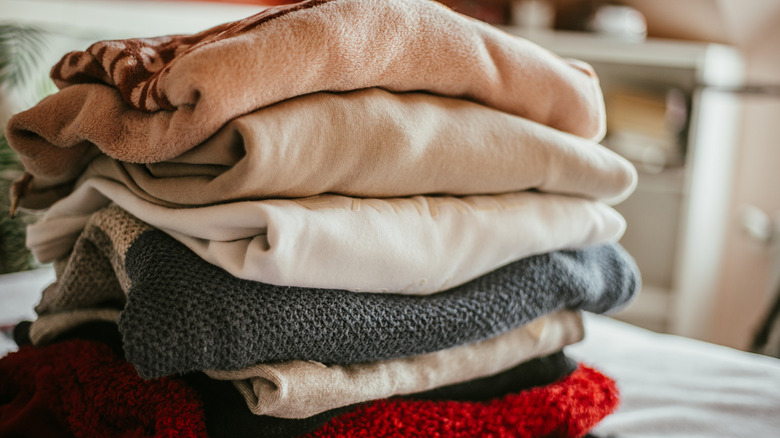12 Common Items You Can Declutter Now For A Cleaner, Tidier Home
We may receive a commission on purchases made from links.
Do you ever feel like you're spinning your wheels when it comes to cleaning? You dedicate a whole day to scrubbing and organizing your house, only for laundry to litter the floor, toiletries to scatter across countertops, and travel mugs to accent every flat surface. If that's the case, you might have a clutter problem. When you have a ton of stuff packed into your house, it becomes difficult to manage it all, and the messes appear without warning. To curb that issue, you need to declutter to lessen the load. But what, exactly, should you get rid of?
There are several common items that you can prune to ensure you have a cleaner, tidier home. These things are often owned in multiples, meaning you have more than one version of them, and they quickly take over the house. While they may be useful, having 10 different varieties creates clutter that spreads. By purging some of these items, you'll be able to minimize the weekly mess that seems to accumulate without you noticing.
Duplicate kitchen cooking utensils
The kitchen is one of those rooms that seems to get messy as soon as you clean it. And part of the reason for that is that we have duplicates of so many items, including cooking utensils. When you have four of everything, from ladles to spatulas, it creates clutter. Drawers are overflowing, utensil holders are jumbled, and it seems like your dishwasher and sink are constantly filled with dirty items. That's because, rather than just using one spatula and cleaning it right away, you may use all five and need to wash the entire mismatched collection. And since there is such a bulk of them, they're more difficult to store because they can take up several drawers rather than just one. This makes it easier to take one out and leave it on the counter or misplaced in a drawer rather than its designated spot.
So, decluttering your collection can leave you with a cleaner, tidier kitchen. Take out all of your cooking utensils and group them into like piles. This will help you see how many duplicates you have. You might be shocked to learn that you have four strainers and barely ever make pasta. Then, remove all of the duplicates and only leave one of everything. Choose the version that is the newest or highest quality, and then donate the rest. Or, if you have a difficult time getting rid of stuff, use a simple tip to declutter your kitchen without going overboard. Box up the extras and put them in storage in the garage or basement. That way, you can grab a replacement if the time ever comes, but it won't contribute to a mess.
Tupperware that isn't functional
The mountain of food storage containers we all seem to accumulate is another cause of kitchen clutter. Whether you forgot how many sets you already had and kept buying more, or you couldn't help yourself to a great sale, it seems like the Tupperware cabinet is always overflowing. And due to the sheer volume at our disposal, the pieces are constantly being used, filling the sink or dishwasher with their volume. And while there are lots of genius ways to keep your plastic food containers organized, limiting the amount you own will bring more order to your kitchen.
The best way to do so is to automatically get rid of any pieces without lids or with misshapen parts. The ones without lids are a no-brainer to toss. However, if some have uneven or shrunken lids that don't seal closed due to getting warped in the dishwasher, those can also go. What will be left is a usable collection. However, if you have more than you know you'll ever use at once, then continue to eliminate some. Remove pieces with permanently stained lids or that are too big or small for your food-storage habits. Or, if you have an excessive amount of a particular size, you can get rid of some of those as well.
Tons of travel mugs or tumblers
Much like the Tupperware cabinet, the travel mug or water tumbler cabinet can turn into pure chaos. That's because many of us have a weakness for buying new ones. You come across one with a fun color or an interesting print, and it goes into your shopping cart. Because of this, you can end up with way more than you'll ever use in a given day. You may find them dispersed across the house, whether left abandoned on the kitchen counter, the edge of your desk, or on the coffee table. They also create clutter in the dishwasher or sink, forcing you to clean and put away multiple cups a day. And if you don't feel like tackling the task right away, they'll pile up.
To declutter your collection, round up your items and automatically toss anything that has a missing lid, broken straw, or cracked part. Then, order them from your most to least favorite. Depending on how many you have, donate your least favorite ones. This will leave you with a much more manageable collection.
Extra bedding you never use
Another area of the house that gets messy quickly is the linen closet. Try as you might, if you have a surplus of bedding, things begin to get disorganized. If you don't have much room, sheets get crammed to max capacity on shelves, stacks topple over as you try to get to something specific, and sets get separated as you root around. If it always feels like your linen closet is in a constant state of chaos, the best thing to do isn't to create a new storage system. It's to get rid of the sheets and blankets that you don't use.
Start by removing everything from the shelves and pairing full sets together. If you find that some are missing pillowcases, consider donating them or repurposing the old sheets around the house. Next, toss any that are stained, ripped, pilling, or threadbare. Lastly, whittle your collection down further by removing anything that's no longer your style or that you constantly skip over. What should be left are your favorite, best quality sheets that take up far less space. If you want to take it a step further and corral the pieces in a container, there are organizational items you can use to declutter your linens. Containers like the SpaceAid's Bed Sheet Organizers look like large binders and can be labeled so you can quickly find the set you're looking for.
Mismatched or worn-out socks
Are you tired of your sock drawer always looking like a bomb went off in it? If it's constantly overflowing, you struggle to find pairs you actually like to wear, and it gets messy just a day or two after organizing, then it's time to edit your collection. This is especially true if you have a system in place, such as a sock organizer or a series of small bins, and it still gets messy. That means the issue isn't a lack of a system, but that there are just too many pieces to contend with.
To declutter, remove any pairs that are mismatched or worn out. If you only have one lone sock or there is a giant hole at the heel or a small one forming at the toe, toss that pair. You won't be reaching for them to begin with, and they're just adding clutter to your drawer. Next, get rid of anything that looks washed out (think black socks that now look more of a charcoal or white socks that have gone dingy) and anything stretched out. This should leave you with not only your best pairs, but a more manageable amount.
Extra towels or wash cloths you don't need
Similar to the linen closet debacle, get your bathroom closet into shape by removing any extra towels or washcloths you don't use. Not only does a surplus of towels create extra loads of unnecessary laundry, but they also make the cabinet feel cramped and disorganized since they're piled onto the shelves. To make them more manageable, narrow down your collection.
While you will want extra sets of towels for when guests come or when you don't have time to do laundry, that doesn't mean you need 15 different sets. A good rule of thumb is to have three towels per person. That gives you enough wiggle room to have one in use, one in the laundry hamper, and one in the closet, just in case. To help you prune your clutter, start by removing any towels that have frayed or lost their vibrancy after years of hot washes. Next, move on to anything that has bleach stains on it or white towels that are discolored. Lastly, toss anything that no longer feels good on your skin, whether because it has become threadbare or scratchy. If you still have a hefty collection leftover, take the extra step and remove any pieces that are hard to wash. For example, is a bath sheet too heavy for your washing machine, so you rarely use it as a result? It might be time to donate or repurpose it.
Nearly empty or expired toiletries
The next place to tackle in your bathroom is your vanity. If it's overrun with beauty and self-care products and, as a result, your countertops become cluttered, it's time to cut back on how much you have. Imagine how tidy your bathroom would be if you only had one face lotion, one hair spray bottle, and one face wash. However, most of us love our self-care items, and something so extreme may not be realistic. But you can quickly declutter your collection to make it more manageable while also streamlining the process of getting ready.
The first thing to toss is expired toiletries. You shouldn't use them any longer, so there's no need to keep them. Next, consider throwing out nearly empty bottles that you've moved on from. Lastly, get rid of anything you've tried but didn't like. Whether a certain lotion had too strong a fragrance or a shampoo left your hair feeling oily, eliminate it from your selection. With fewer products to choose from, not only will your cabinets be simple to organize, but you'll have fewer products on the countertops, making them easier to manage.
Free marketing gear like tote bags and t-shirts
We accumulate free swag all the time. Whether you got a tote with an online purchase or a free t-shirt for attending an event, we tend to keep these things "just in case." For example, you can use canvas bags to haul groceries and a logoed t-shirt to do chores around the house. But when you have 15 event shirts and are drowning in promotional totes, your storage can easily get overrun. If you want a more organized and clutter-free closet, these items are some of the first things that should go.
To declutter them, be realistic with how many of them you actually need. A tote or two can be useful if you go to a farmers' market, but you will never use 13 options in a given week. And while it's handy to have a few t-shirts on hand that you don't mind doing housework, gardening, or renovations in, you likely won't need an entire collection of them. So, try to keep two to three of your favorite ones, and donate the rest.
Sneakers or casual shoes that you don't wear
Are shoes constantly cluttering your entryway? Do you have a messy pile of sneakers constantly cluttering the bottom of your closet? If so, decluttering your collection is the fastest way to get these problem areas under control. The fewer pairs you have to keep track of, organize, and put away, the less of a mess you will create.
The easiest way to do this is to tackle your sneakers and casual shoes, which many people have the biggest surplus of. First, toss any pairs that are falling apart. If you have shoes where the soles are separating from the shoe, straps are broken, or they have been scuffed or damaged beyond repair, toss them in the bin. Next, remove any uncomfortable shoes. These are the ones you rarely wear because they cause blisters or cramp your feet, so they just take up storage space. If you still have a large collection, take it a step further and donate or sell any shoes you have barely worn because they're not your style or just aren't practical. Most of us hang onto wardrobe items because of a sunk-cost fallacy, where we feel guilty for spending money on a piece and hang onto it even if we never intend to wear it. Give yourself permission to acknowledge the error in judgment, and remove it from your closet for the sake of a cleaner, tidier home.
Loungewear like sweatpants, sweatshirts, and leggings
People love to be comfy at home, which is why most of us have a robust collection of sweatpants, sweatshirts, and leggings. But if you find piles of them heaped on your bedroom chair, closet floor, or creating general havoc in your dresser drawers, it's time to declutter. When you have a surplus of options, it's much easier to grab a fresh set each time than make sure to launder and put away dirty ones for future use. And when you finally do get around to doing the laundry, you have an intimidating stack of loungewear to put away, prompting many of us to leave it in a pile for a later time.
To nip this issue in the bud, pare down your collection. Remove all of your pieces and spread them across your bed and bedroom floor. Then, remove anything that's stained, ripped, or threadbare. You can repurpose these items into rags or recycle them. Next, remove any sets that no longer fit you correctly, whether they're too tight, shrunk in the wash, or are too large, and consider donating these. If you still have a large surplus and want to continue decluttering your closet, move on to removing anything you rarely wear, whether it's out of style or because you have a rotation of better options.
Too many throw blankets
One might think they can never have enough blankets, but if you walk into your living room and the couch looks messy with unfolded throws, then it's time to declutter. If you have a surplus of blankets, no number of wicker baskets or ladders will help you neatly corral them, thanks to their size and bulk. Plus, finding the willpower to fold up and put away all the pieces can be tricky, leading to a mess on your hands.
So instead, narrow down your choices. Allocate a certain number of blankets per person in the household, and if you don't want to get rid of the rest, consider putting them in storage, whether in a linen closet or a large storage bin stashed in the garage or basement. This will allow you to rotate your blankets, bringing new ones out due to a change of season or for a refresh. It will also enable you to keep all the ones you like, but not have all of your options out on display.
Duplicate tools for the same tasks
Even if you're not an experienced handyman, you likely have a tool bag somewhere in your house. Many people need the essentials, from hammers to screwdrivers, to fix common mishaps or build a quick piece of furniture. However, an issue occurs when you repeatedly purchase sets, resulting in duplicates of some of these tools. Maybe you bought a particular set because it had some specialty tools you needed, but also had a few pieces you already owned, or maybe you upgraded to a better quality version. Whatever the reason, the end result is that you now have two hammers, three screwdrivers, and three measuring tapes, and these items are in constant disarray in your basement or garage. To make those spaces feel perpetually cleaner, prune back the multiples.
The easiest way to do so is to keep just one of each tool, and choose the one that's of the best quality. However, if you feel like you might need a backup eventually, you can declutter it using a different method. If you have two floors or multiple utilitarian rooms like a mudroom and a separate laundry space, then consider breaking up the collection between the two areas. Or, if you don't need the same tools in different sections of the house, box up your duplicates and store them in a labeled container in your garage. If your screwdriver becomes stripped or your hammer breaks, then you can grab the replacement from the overflow container.

